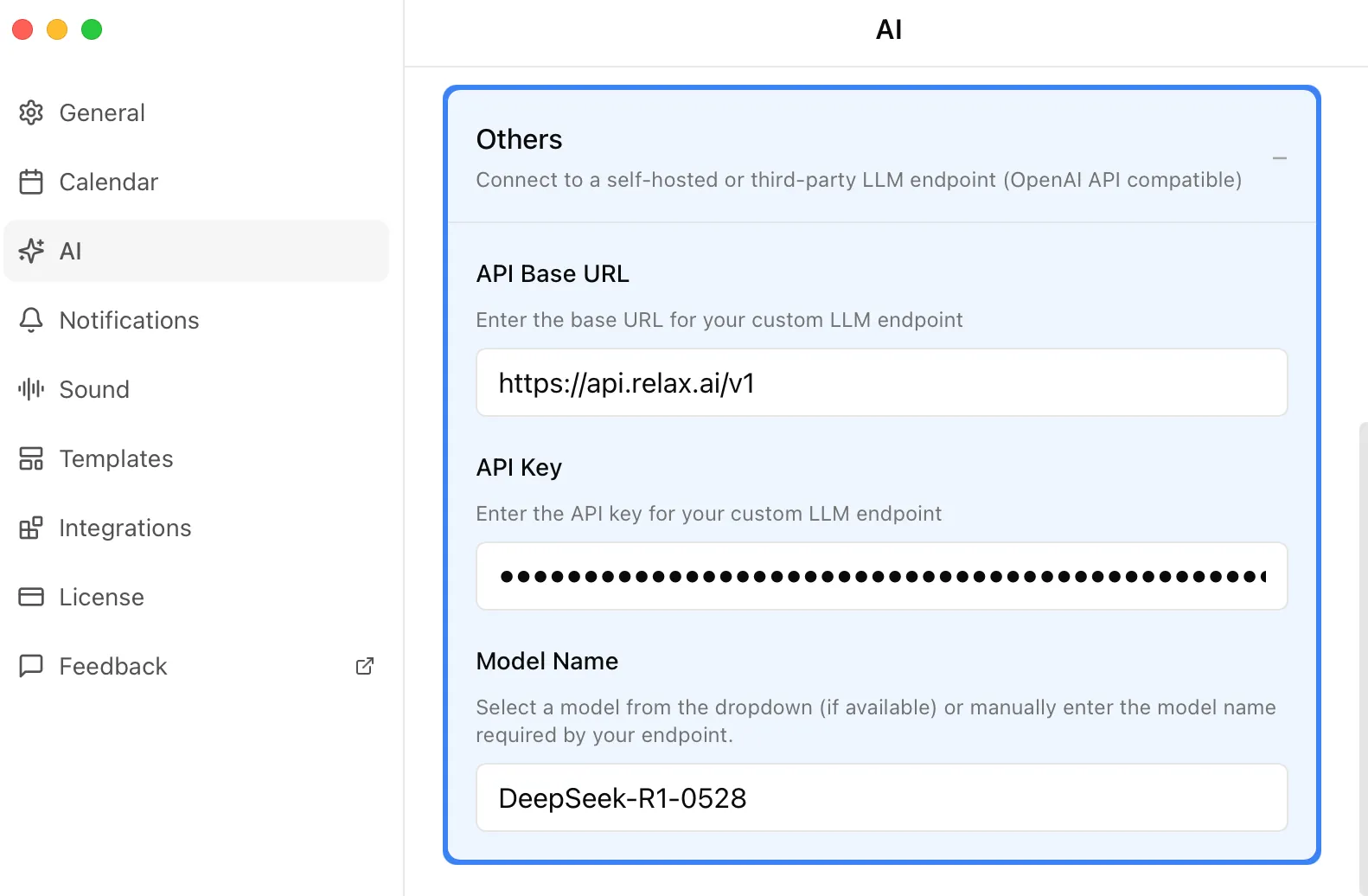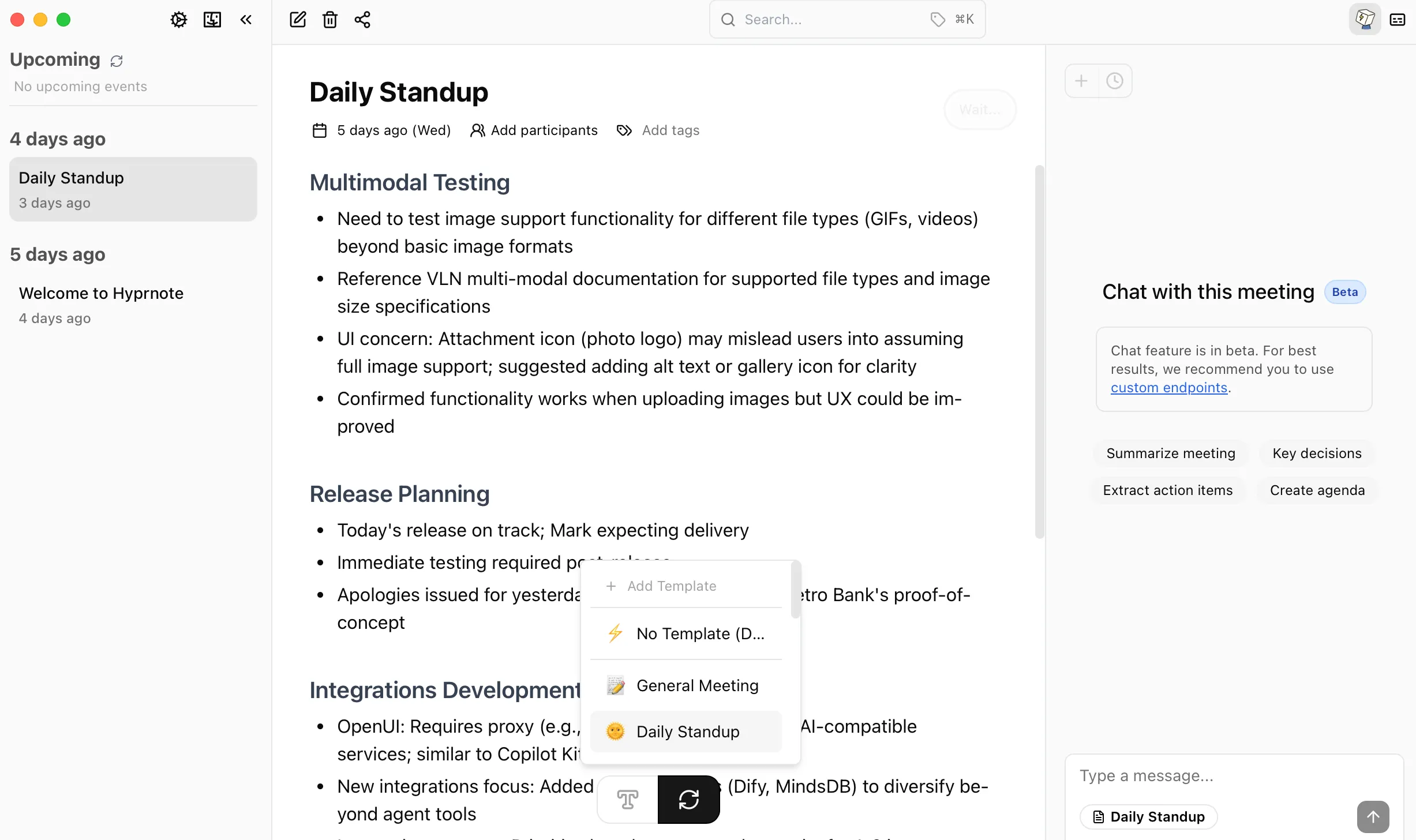Hyprnote Integration
Overview
Hyprnote is an open-source, local-first AI notetaker designed for privacy-conscious professionals. It captures meeting audio, combines it with your notes, and generates comprehensive summaries—all while keeping data entirely on your device. With its extensible architecture and support for custom language models, Hyprnote offers a secure alternative to cloud-based meeting assistants.
Perfect for professionals in regulated industries or privacy-conscious organizations who need AI-powered meeting assistance without compromising data security.
Key Features
- 100% Local Processing: No data leaves the local device, ensuring complete privacy
- Offline Capability: Works without internet connection
- Real-time Transcription: Live transcript updates during meetings
- AI-Powered Summaries: Combines your notes with audio context
- Extensible Architecture: Plugin system similar to VS Code
- Custom Model Support: Integrate custom language models
- Audio Source Flexibility: Captures both microphone and system audio
- Template Support: Choose from predefined summary formats
- Chat Interface: Interact with your meeting notes and summaries using an LLM-powered chat interface
Use Cases
- Taking notes during sensitive corporate meetings
- Recording and summarizing back-to-back meetings
- Creating meeting summaries for compliance-heavy industries
- Documenting interviews and research sessions
- Capturing insights from virtual and in-person meetings
- Building custom meeting workflows with extensions
Installation
-
Install Hyprnote on macOS using Homebrew:
Terminal window brew tap fastrepl/hyprnotebrew install hyprnote --cask -
Launch Hyprnote from Applications or using Spotlight search
-
Grant necessary permissions:
- Microphone Access: For capturing meeting audio
- Screen Recording: For system audio capture (virtual meetings)
Refer the Hyprnote documentation for detailed installation instructions.
RelaxAI Integration Setup
Since Hyprnote runs entirely locally, you’ll need to configure it to use RelaxAI’s API for enhanced language model capabilities.
Method 1: In-App Configuration
-
Open Hyprnote preferences:
Cmd + , -
Navigate to “AI” section
-
Naviagte to “LLM - Custom” tab
-
Configure settings under Others section for OpenAI API compatible models:
- API Base URL:
https://api.relax.ai/v1 - API Key:
RELAX_API_KEY - Model Name:
DeepSeek-R1-0528

- API Base URL:
Method 2: Environment Configuration
-
Create a configuration file in your home directory:
Terminal window mkdir -p ~/.hyprnotetouch ~/.hyprnote/config.json -
Add RelaxAI configuration:
{"llm": {"provider": "openai-compatible","endpoint": "https://api.relax.ai/v1","apiKey": "RELAX_API_KEY","model": "DeepSeek-R1-0528","temperature": 0.7,"maxTokens": 2048},"transcription": {"provider": "local","model": "local-model-name"},"summary": {"style": "bullet-points","includeActionItems": true,"includeDecisions": true}}
Core Functionality
Real-time Meeting Capture
-
Start a Meeting Session
- Click the “New Meeting” button or press
Cmd + N - Choose audio source:
- Microphone only (in-person meetings)
- System audio (virtual meetings)
- Both (hybrid meetings)
- Click the “New Meeting” button or press
-
Take Notes During Meeting
Quick notes interface:- Key points appear here- @action items get highlighted- #decisions are tracked- Links and references preserved -
Generate Summary
- Click “Generate Summary” or press
Cmd + S - Hyprnote combines your notes with transcript
- RelaxAI processes and generates structured output

- Click “Generate Summary” or press
-
Chat with Meeting Notes
- Use the chat interface to ask questions about the meeting
- RelaxAI provides context-aware responses based on notes and summaries

Summary Templates
Configure different templates for various meeting types:
{ "templates": { "standup": { "sections": ["Yesterday", "Today", "Blockers"], "prompt": "Summarize as a daily standup update" }, "client-meeting": { "sections": ["Discussion Points", "Action Items", "Next Steps"], "prompt": "Create a professional client meeting summary" }, "brainstorming": { "sections": ["Ideas Generated", "Key Themes", "Decisions", "Follow-ups"], "prompt": "Organize brainstorming session outcomes" } }}Advanced Features
Custom Prompt Engineering
Optimize RelaxAI’s output with custom prompts:
{ "prompts": { "summary": { "system": "You are an expert meeting summarizer. Focus on actionable insights and clear decision points.", "user": "Meeting context:\n{{transcript}}\n\nMy notes:\n{{notes}}\n\nCreate a summary with sections: Key Decisions, Action Items (with owners), and Next Steps." }, "action_extraction": { "system": "Extract only concrete action items with clear owners and deadlines.", "user": "Find all action items in: {{content}}" } }}Performance Optimization
- Model Selection: Use smaller local models for transcription, RelaxAI for summaries
- Batch Processing: Process multiple meetings during off-hours
- Caching: Enable summary caching for frequently referenced meetings
- Audio Quality: Use external microphone for better transcription accuracy
- Memory Management: Configure max memory usage in preferences
Troubleshooting
- Audio not capturing: Check System Preferences → Security & Privacy → Microphone/Screen Recording
- RelaxAI connection failed: Verify API endpoint and key in configuration
- Slow summary generation: Reduce max tokens or use streaming responses
- Extension not loading: Check extension logs in
~/.hyprnote/logs/ - Memory issues: Limit concurrent meeting sessions in preferences
- Transcription accuracy: Ensure quiet environment or use noise cancellation
Security Considerations
- All audio processing happens locally by default
- RelaxAI API calls only send text (transcripts/notes), never raw audio
- Store API keys securely using macOS Keychain
- Enable disk encryption for stored meeting data
- Configure data retention policies for compliance
- Use local models for highly sensitive meetings